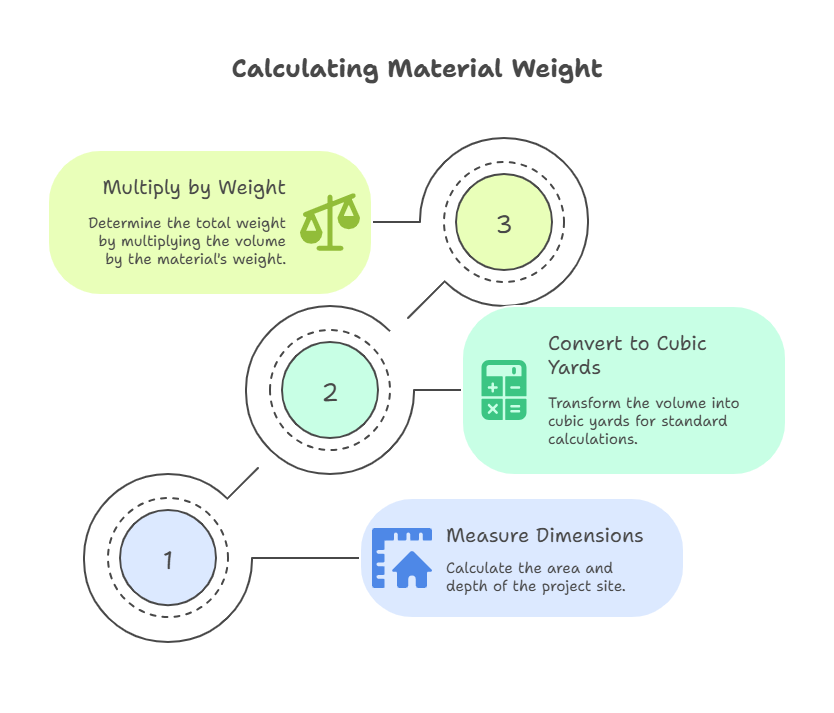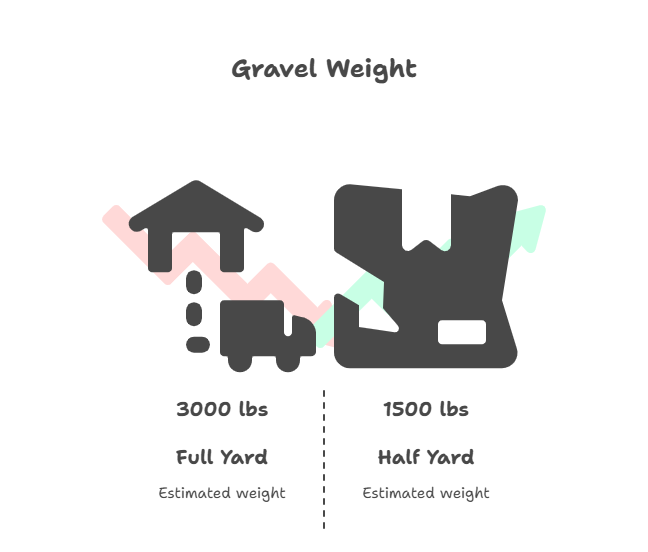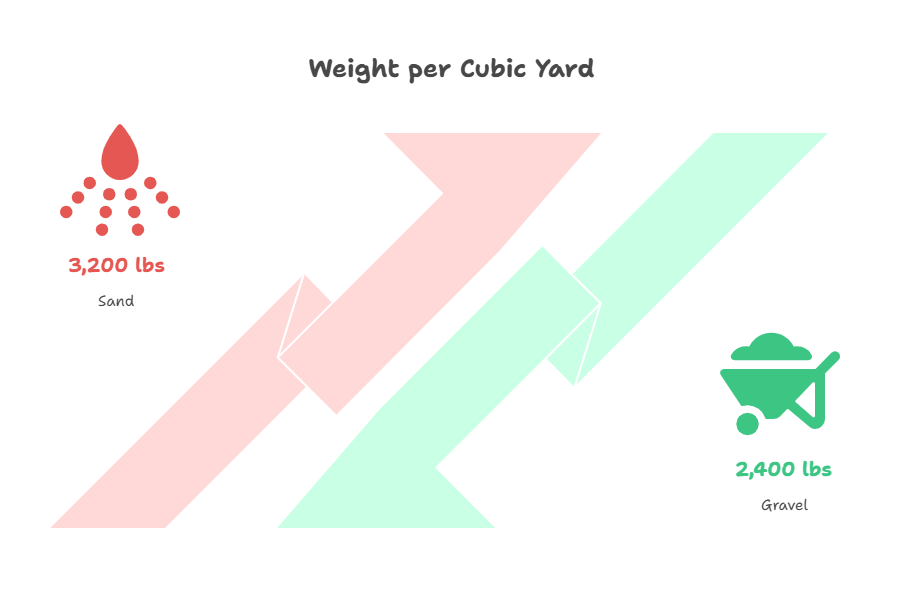If you are starting a landscaping, construction, or home project, one of your first questions is likely: how much does a yard of gravel weigh, and how much does a yard of sand weigh? Knowing these numbers from the start ensures your project runs smoothly, avoids waste, and stays within budget. In this guide, you’ll find detailed weight ranges, conversion tips, material comparisons, and answers to the most common questions, all backed by best practices and real user needs.
How Much Does a Yard of Gravel Weigh?
A typical yard of gravel weighs between 2,400 and 3,000 pounds. This range depends on the size of the stones, the moisture level, and the specific type of gravel you choose. Most professionals use 3,000 pounds as an average for planning. Larger stones and wet gravel increase the weight, while dry, loose gravel is lighter.
For most home and business projects, 3,000 pounds per cubic yard is a safe, reliable estimate. This figure allows you to determine total load requirements, plan for safe delivery, and avoid overworking vehicles or equipment.

Always check with your local material supplier for the exact weight, as different stone types, compaction, and water content can change the numbers.
You can quickly estimate your project needs using our gravel calculator tool.
How Much Does a Yard of Sand Weigh?
A yard of sand commonly weighs between 2,600 and 3,200 pounds. The exact weight depends on if the sand is dry or wet and the grain size. Dry sand often weighs around 2,700 pounds per yard, while wet sand can hit 3,200 pounds or more because water adds to the mass.
For general planning, use 2,700–3,000 pounds per cubic yard when estimating sand needs. This allows for slight differences based on real job-site conditions. Whenever possible, ask your supplier for material that matches your use and get a true weight per yard.
Why Do Gravel and Sand Weights Vary?
Several factors cause differences in the weight of a cubic yard for gravel or sand:
- Moisture Level: Water held within each material significantly increases weight.
- Rock or Grain Type: Larger, angular stones and coarse sand weigh more than round, fine particles.
- Compaction and Density: Materials that are tightly packed or compacted take up less space but weigh more per yard.
- Mix of Materials: Any soil, organic matter, or debris adds or reduces the overall weight.
It is important to consider these factors before ordering to make sure your delivery matches your equipment capacity and project demands.
How to Calculate Weight for Your Project
Accurate calculations prevent the trouble of ordering too little or too much. Here is a step-by-step method you can follow:
- Measure the length, width, and depth of your space in feet.
- Multiply those numbers to get the total cubic feet.
- Divide by 27 to convert to cubic yards (since there are 27 cubic feet in a cubic yard).
- Multiply the number of yards by the average material weight:
- Gravel: 3,000 pounds per yard
- Sand: 2,700 pounds per yard
Example Calculation:
You have a patio that is 12 feet by 10 feet, being filled 3 inches (0.25 feet) deep:
- 12 × 10 × 0.25 = 30 cubic feet
- 30 ÷ 27 = 1.11 cubic yards
- For gravel: 1.11 × 3,000 = 3,330 pounds needed
- For sand: 1.11 × 2,700 = 2,997 pounds needed
This calculation helps you plan for delivery and know how much material to order. For detailed measurements specific to smaller stones, try our pea gravel calculator.
Practical Uses for Knowing the Weight of Gravel and Sand
Understanding the real weight of these materials helps you:
- Choose the right delivery method. Most pickup trucks handle about 1,500 pounds, which means you might need to split a full yard into two trips.
- Avoid overloading equipment or trailers, which protects your vehicle and keeps your job safe.
- Schedule deliveries during dry periods, as wet material is much heavier and can strain your crew or tools.
- Stay within budget by measuring exactly what you need instead of making costly, last-minute orders.
Read More = How Much Sand Do I Need? Accurate Calculations for Every Project
Gravel or Sand: Choosing the Right Material for the Job
- Gravel: Best used for driveways, drainage, foundational support, and creating stable bases for heavy loads.
- Sand: Ideal for soft, level foundations such as patios and playgrounds, as well as detailing work under pavers or bricks.
Your choice should match the specific application and location conditions, from soil type to expected foot traffic.

Factors That Affect Transport and Delivery
- Weight Limits: Keep in mind the maximum load your vehicle can handle.
- Worksite Access: Plan for easy dumping or spreading, especially if you have limited space or wet ground.
- Weather Conditions: Wet weather increases weight and can make both sand and gravel more difficult to move.
Before any order, talk with your supplier about your project details to get their advice on load sizes and the best delivery approach.
Gravel and Sand Weight Conversion Table
| Material | Pounds per Yard | Tons per Yard |
|---|---|---|
| Dry Gravel | 2,400–2,900 | 1.2–1.45 |
| Wet Gravel | 2,800–3,400 | 1.4–1.7 |
| Dry Sand | 2,600–2,800 | 1.3–1.4 |
| Wet Sand | 3,000–3,200 | 1.5–1.6 |
Use this chart for easy reference when ordering or measuring material.
Pro Tips for Working with Bulk Materials
- Always measure your site carefully before ordering.
- Opt for slightly more material than calculated to handle settling or grading adjustments.
- Organize delivery logistics early. Speak with your supplier for drop-off advice based on truck and driveway restrictions.
- Use safe lifting and transport methods, especially for heavier loads and when working in wet conditions.
Read More = What is Gravel: Types, Uses and Complete Construction Guide
Gravel and Sand: Key Safety and Cost Considerations
Handling gravel or sand is not just about numbers. Weight impacts labor, equipment, and total project cost. Save money by minimizing wasted trips and reduce injury risk by knowing your limits. For the best outcome, work with local suppliers who can provide up-to-date weights and packaging.
To learn more about volume calculations, you can visit the official cubic yard Wikipedia page.
Conclusion: Getting the Right Weight for Your Yard of Gravel or Sand
A yard of gravel generally weighs about 3,000 pounds, while a yard of sand falls between 2,700 and 3,200 pounds depending on type and moisture. Knowing these figures helps you plan, order, and complete your project with confidence whether you are building a driveway, laying a patio, or filling a sandbox. Use the calculations, pro tips, and table provided to simplify tasks, save time, and avoid project surprises.
Frequently Asked Questions
How many tons are in a yard of gravel?
A yard of gravel usually equals 1.3 to 1.5 tons, but wet or unusually dense gravel could weigh up to 1.7 tons. Always check with your supplier before ordering to be sure you get the right amount for your needs.
How many pickup loads does it take to move a yard of gravel or sand?
Most standard pickup trucks have a maximum load of about half to three-quarters of a yard of gravel or sand. Plan for two trips for a full yard and check your vehicle’s manual for capacity facts.
What’s the difference in weight between dry and wet sand?
Dry sand weighs around 2,700 pounds per yard. Wet sand can reach up to 3,200 pounds because water adds extra mass. Account for this difference if your sand will be exposed to rain or moisture.
Can I use the same volume of gravel and sand for the same job?
Not always. Sand compacts more than gravel and may settle, so you may need to order slightly extra sand to match the coverage of gravel in some projects. Use a project calculator for the best estimate.
Read More = Best Stone Calculator
How do I calculate pounds or tons from cubic yards?
Multiply the cubic yards by the average weight for each material: 3,000 pounds for gravel, 2,700 pounds for sand. To find tons, divide that number by 2,000 for an approximate total.
What is the best type of gravel or sand for landscaping projects?
For walkways and patios, smaller, crushed gravel works best as it compacts well. For sand bases under pavers or playgrounds, use washed concrete or masonry sand for a level surface.
How can I make moving gravel or sand easier and safer?
Use a smaller shovel, break large tasks into smaller loads, or get help if possible. Wear gloves and consider moving material when it’s slightly damp, as this reduces dust and mess.
